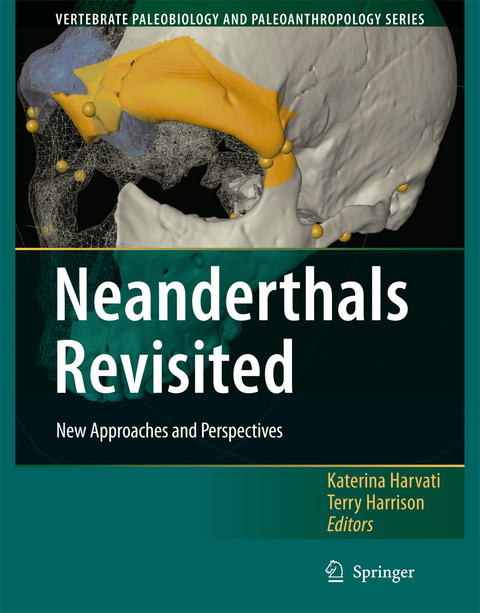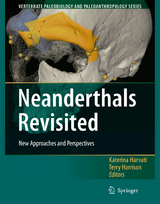Neanderthals Revisited
Springer-Verlag New York Inc.
978-1-4020-5120-3 (ISBN)
Topics addressed include the re-evaluation of Neanderthal anatomy, inferred adaptations and habitual activities, developmental patterns, phylogenetic relationships, and the Neanderthal extinction; new methods include computer tomography, 3D geometric morphometrics, ancient DNA and bioenergetics. The diverse contributions offer fresh insights and advances in Neanderthal and modern human origins research.
This is a Volume in The Max-Planck-Institute Subseries in Human Evolution coordinated by Jean-Jacques Hublin, Max-Planck-Institute for Evolutionary Anthropology, Department of Human Evolution, Leipzig, Germany
Katerina Harvati is senior researcher at the Max Planck Institute for Evolutionary Anthropology and adjunct Associate Professor at the Anthropology Department of the City University of New York Graduate School. Dr. Harvati is a paleoanthropologist specializing in Neanderthal evolution and modern human origins. Her broader research interests include primate and human evolution, evolutionary theory, life history and paleolithic archaeology. She has conducted fieldwork in Europe and Africa and is currently directing paleoanthropological research in Northern Greece. Her work has been published in the Proceedings of the National Academy of Sciences (USA), the Journal of Human Evolution, the American Journal of Physical Anthropology and elsewhere. Terry Harrison is Professor of Anthropology and Director of the Center for the Study of Human Origins at New York University. His main research interests include all aspects of human and primate evolution. He has conducted paleontological field research in Europe, East Africa, and Asia, and he is currently directing research at the early hominin locality of Laetoli in Tanzania. He has published extensively on the evolutionary relationships and paleobiology of Miocene hominoids, East African vertebrate paleontology, and comparative anatomy. He is the editor of Neogene Paleontology of the Manonga Valley, Tanzania (Plenum Press).
Neanderthals revisited.- The distinctiveness and systematic context of Homo neanderthalensis.- Saccopastore 1: the earliest Neanderthal? A new look at an old cranium.- Inquiries into Neanderthal craniofacial development and evolution: “accretion” versus “organismic” models.- Neanderthals and modern humans — chimps and bonobos: similarities and differences in development and evolution.- Cranial growth models: heterochrony, heterotopy, and the kinematics of ontogeny.- Bioenergetic perspectives on Neanderthal thermoregulatory and activity budgets.- How different were Neanderthals' habitual activities? A comparative analysis with diverse groups of recent humans.- Neanderthal hands in their proper perspective.- Did Neanderthals make the Châtelperronian assemblage from La Grotte du Renne (Arcy-sur-Cure, France)?.- The fate of European Neanderthals: results and perspectives from ancient DNA analyses.- Selection Selection on mitochondrial DNA and the Neanderthal problem.- Reliability of cranial morphology in reconstructing Neanderthal phylogeny.- Non-metric variation in recent humans as a model for understanding Neanderthal-early modern human differences: just how “unique” are Neanderthal unique traits?.- Earliest Upper Paleolithic crania from Mlade?, Czech Republic, and the question of Neanderthal-modern continuity: metrical evidence from the fronto-facial region.- Neanderthals and modern humans: an example of a mammalian syngameon?.- Speciation by distance and temporal overlap: a new approach to understanding Neanderthal evolution.- The Neanderthal-H. sapiens interface in Eurasia.
| Erscheint lt. Verlag | 28.11.2007 |
|---|---|
| Reihe/Serie | Vertebrate Paleobiology and Paleoanthropology |
| Zusatzinfo | XIV, 332 p. |
| Verlagsort | New York, NY |
| Sprache | englisch |
| Maße | 210 x 297 mm |
| Themenwelt | Geisteswissenschaften ► Archäologie |
| Naturwissenschaften ► Biologie ► Evolution | |
| Naturwissenschaften ► Biologie ► Humanbiologie | |
| Naturwissenschaften ► Biologie ► Zoologie | |
| Naturwissenschaften ► Geowissenschaften ► Mineralogie / Paläontologie | |
| Sozialwissenschaften ► Ethnologie | |
| Sozialwissenschaften ► Soziologie | |
| ISBN-10 | 1-4020-5120-4 / 1402051204 |
| ISBN-13 | 978-1-4020-5120-3 / 9781402051203 |
| Zustand | Neuware |
| Haben Sie eine Frage zum Produkt? |
aus dem Bereich




